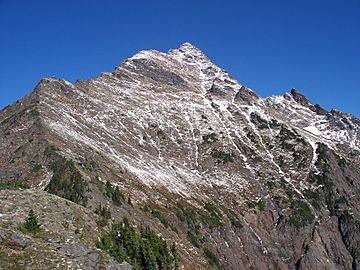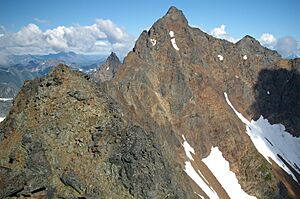Welch Peak facts for kids
Quick facts for kids Welch Peak |
|
|---|---|

Welch Peak in October 2008
|
|
| Highest point | |
| Elevation | 2,431 m (7,976 ft) |
| Prominence | 1,441 m (4,728 ft) |
| Listing | List of mountains of Canada |
| Geography | |
| Parent range | Cheam Range |
| Climbing | |
| First ascent | 1924 by A. Cooper, F. Smith, and F. Spouse |
Welch Peak is a tall mountain in British Columbia, Canada. It stands about 2,431 meters (7,976 feet) high. This makes it the highest point in the Cheam Range. The mountain is located near the city of Chilliwack.
The mountain is named after a person named Welch. He was part of an engineering company. This company built and ran a mine nearby called the Lucky Four Mine. Other mountains close by are also named after his business partners, Foley Peak and Stewart Peak.
How Welch Peak Was Formed
Welch Peak is part of a group of mountains called the Cascade Range. These mountains were shaped over millions of years. Deep inside the Earth, hot melted rock pushed its way up. This rock cooled and hardened, forming the base of the mountain.
The area around Welch Peak was once part of the Pemberton Volcanic Belt. This means volcanoes were active here a long, long time ago. Over time, these volcanoes wore down, but their rocky foundations remained.
The Power of Glaciers
For more than two million years, huge sheets of ice called glaciers covered this land. These glaciers moved slowly, like giant bulldozers. They scraped and carved the landscape. When the glaciers melted, they left behind lots of rock and dirt.
You can still see the marks left by these glaciers. Many river valleys in the area are shaped like a "U". This "U" shape is a clear sign that glaciers once moved through them. The combination of land pushing up and glaciers carving it out created the tall peaks and deep valleys we see today.
The mountains here have very rugged shapes. They have sharp peaks, rocky ridges, and deep valleys carved by ice. All these natural events created the amazing landscape of the North Cascades. The different heights and shapes of the land also lead to different climates. This is why you see many types of plants and trees growing in this area.
Weather at Welch Peak
Welch Peak has a "marine west coast" climate. This means it gets a lot of rain and snow. Most of the weather comes from the Pacific Ocean. As the air moves east, it hits the Cascade Mountains. The mountains force the air to rise. When the air rises, it cools down and drops its moisture. This causes a lot of rain or snow to fall on the mountains.
During winter, the Cascade Mountains get a lot of snow. Temperatures can drop very low, sometimes below −20 °C. With the wind, it can feel even colder, below −30 °C. If you want to climb Welch Peak, the best time to visit is usually from July to September. The weather is much better and safer then.




